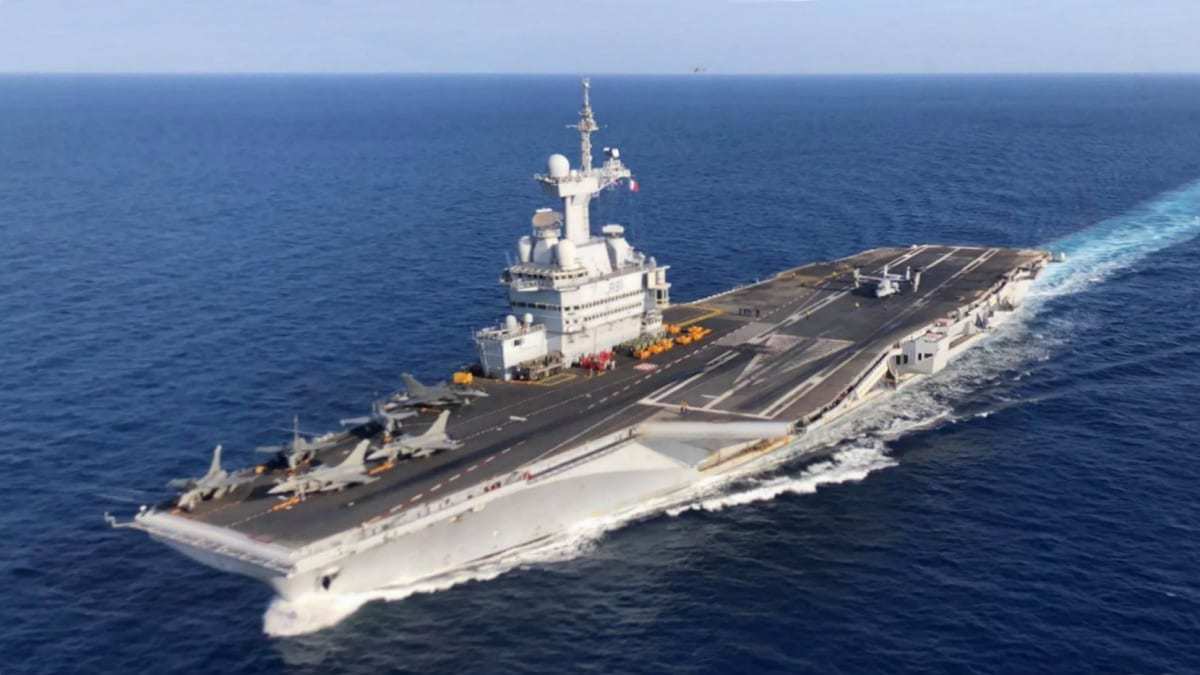PANG: Is France Still Building a New Aircraft Carrier? – Currently, only the United States Navy and the French Marine Nationale (National Navy) operate nuclear-powered aircraft carriers. However, France’s flagship carrier, named for former President Charles de Gaulle, has been in service since May 2001 – and Paris is already looking ahead to its replacement.
Two decades may not be an especially long service history for an aircraft carrier, but Charles de Gaulle has had more than its share of problems during its time in service—much like its political namesake—in addition to its troubled 15-year construction period.
Displacing forty-two thousand tons, Charles de Gaulle is the only nuclear-powered aircraft carrier to serve outside the U.S. Navy and is also the only carrier in the world apart from the U.S Navy to utilize catapults to launch aircraft and consequently carries conventional CATOBAR-capable jets such as the Dassault Rafale and the E-2C Hawkeye. While the French flattop will remain in service until 2040, Paris has already been thinking about the next carrier and given the trouble that it had with the Charles de Gaulle, it is truly taking its time to get it right.
Meet the PANG
Dubbed the Porte-Avions de Nouvelle Génération (PANG) – “New Generation Aircraft Carrier” – it will likely be similar in size to the Charles de Gaulle, and likely would have an air wing that includes upwards of 32 next-generation fighter jets, possibly an aircraft carrier-capable version of the now-in-development Future Air Combat System (FACS) fighter being developed with Germany and Spain.
The future PANG would likely be nuclear-powered with two K22 reactors, which would give it nearly unlimited range and endurance. President Emmanuel Macron had essentially confirmed that fact nearly two years ago.
“The Charles de Gaulle, as you know, will come to the end of its life in 2038,” Macron said in a late 2020 address. “This is why I have decided that the future aircraft carrier that will equip our country and our navy will be nuclear-powered like the Charles de Gaulle. Your plant in Le Creusot, which has been producing parts essential to our navy for a long time, will produce, among others, several major parts of the nuclear boiler of the future aircraft carrier by forging and machining them right here […] By these choices we confirm France’s desire to preserve its strategic autonomy.”
Where is the PANG Program?
It was announced that the first steel cut is now on track for 2025, so technically the PANG is still in the research and development (R&D) stage. As it also stands, the Marine Nationale expects that the ship’s sea trials could begin in 2036 with formal commissioning to take place in 2038.
That may not give a lot of “wiggle room,” as Charles de Gaulle could reach her end-of-life around 2040. Given that the current flagship had a prolonged development cycle, this timeline could leave France without a carrier – a situation the Royal Navy faced after it retired the last Invincible-class carrier, HMS Illustrious, in 2014, which left the British without a flattop for the first time in a century.
The PANG program is also notable in that it was created in the aftermath of an aborted attempt to construct a carrier in cooperation with the UK and its two 65,000-tonne Queen Elizabeth-class ships.
PANG: The Current Specs
According to a report last year from Janes, the future 70,000-tonne French aircraft carrier will have the capability to launch up to 60 fighter sorties a day and have a week of ammunition for high-intensity operations. In addition, five or six helicopters and two E-2D airborne early warning and control aircraft will also initially be involved in air operations.
Future plans call for the operation of unmanned aerial vehicles (UAVs), which could serve as loyal wingmen to support NGFs, while the French Navy has reportedly been paying attention to U.S. experiments with aerial-refueling UAVs.

190424-M-BP588-1005 U.S. 5TH FLEET AREA OF OPERATIONS (April 24, 2019) A U.S. Marine MV-22 Osprey assigned to the 22nd Marine Expeditionary Unit sits on the flight deck of France’s Marine Nationale aircraft carrier FS Charles De Gaulle (R 91). This was the second time that Ospreys have landed aboard the French vessel. Marines and Sailors assigned to the 22nd MEU and Kearsarge Amphibious Ready Group are currently deployed to the U.S. 5th Fleet area of operations in support of naval operations to ensure maritime stability and security in the Central region, connecting the Mediterranean and the Pacific through the western Indian Ocean and three strategic choke points. (U.S. Marine Corps photo by Maj. Joshua Smith/Released)
The crew comforts could be improved, as berthing compartments will be limited to just eight sailors – compared to the maximum 24 on the Charles de Gaulle. The crew size would likely be a maximum of 1,100, along with an additional 600 for the airwing.
It is still possible many of these details could change, but for now, the Marine Nationale is set to steam full-speed ahead with the PANG.
A Senior Editor for 1945, Peter Suciu is a Michigan-based writer who has contributed to more than four dozen magazines, newspapers and websites. He regularly writes about military hardware, firearms history, cybersecurity and international affairs. Peter is also a Contributing Writer for Forbes. You can follow him on Twitter: @PeterSuciu.

